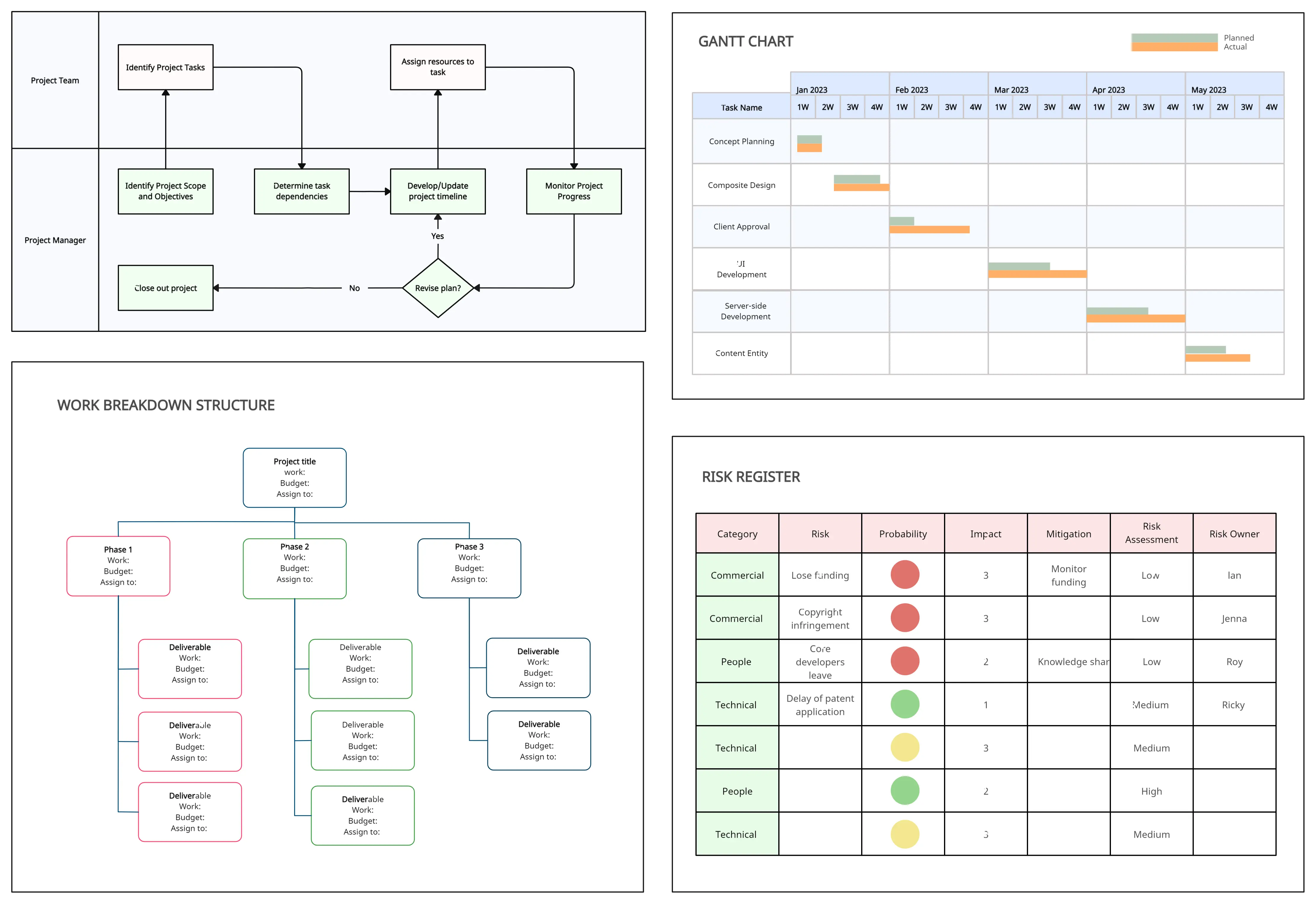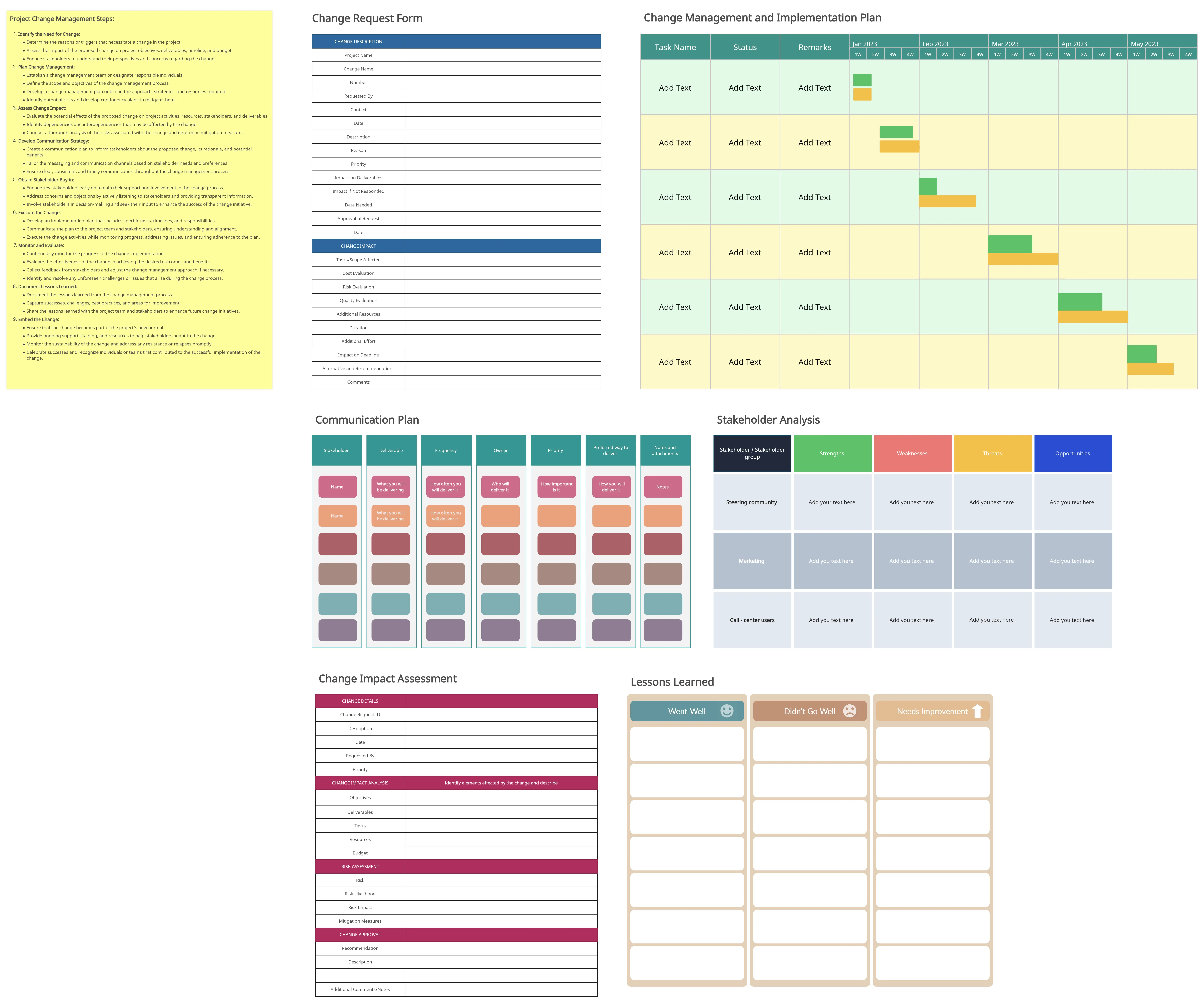The ability to effectively execute projects and manage change is critical to achieving successful outcomes. This comprehensive guide is designed to equip you with essential yet customizable templates and guidelines necessary for project execution and change management planning.
At Creately, we understand the challenges faced by professionals in project execution and change management. That’s why we are dedicated to providing complete and customizable project execution and change management plan templates to our users. With this guide, we aim to not only provide you with these templates but also offer valuable insights and guidelines to enhance your understanding and application of project execution and change management practices. Let’s get started.
- What is Project Execution
- What is Change Management
- Project Execution Plan Template
- Change Management Plan Template
- Best Practices for Effective Project Execution
- Change Management Best Practices
What is Project Execution?
Project execution is the phase where the planned tasks and activities are performed to reach project goals and deliverables. It involves putting the project plan into action and coordinating resources, stakeholders, and actions to ensure successful project completion.
During project execution, project managers and teams put a carefully crafted project plan into action. They assign responsibilities, manage resources, monitor progress, and make necessary adjustments to stay on track. This phase encompasses all the activities required to bring the project to fruition, from initiating the work to delivering the final results.
Effective project execution is essential for project success. It ensures that the project is completed within the defined scope, budget, and schedule while meeting the desired quality standards. It requires effective coordination, communication, and decision-making to address challenges and drive the project forward.
Key Elements to Effectively Carry Out Project Execution
Planning and Organization: A well-defined project plan serves as a roadmap for execution. It outlines project objectives, deliverables, timelines, and resource allocation. Organizing project tasks, establishing dependencies, and setting clear milestones are crucial elements of effective execution.
Resource Management: Allocating resources appropriately, including human resources, equipment, and materials, is vital for smooth execution. Effective resource management ensures that the right people with the required skills are available at the right time, minimizing bottlenecks and maximizing productivity.
Communication and Collaboration: Strong communication channels and collaborative efforts are vital during project execution. Regular updates, team meetings, and status reports facilitate efficient information exchange and decision-making. It fosters teamwork, enhances transparency, and minimizes misunderstandings.
Monitoring and Control: Tracking project progress, monitoring key performance indicators, and implementing effective control mechanisms enable project managers to stay informed and take timely actions. Monitoring helps identify deviations, risks, and issues early on, allowing for corrective measures to keep the project on track.
Risk Management: Identifying potential risks, assessing their impacts, and developing mitigation strategies are essential for effective execution. Proactive risk management ensures that risks are managed appropriately, minimizing their impact on project objectives.
Benefits of a Well-Executed Project Execution
Well-executed project execution brings several benefits, including,
Timely Completion: Effective execution ensures that the project is completed within the scheduled time frame, enabling timely delivery of project outcomes.
Cost Control: Proper resource allocation, monitoring, and control help manage project costs, avoiding budget overruns and optimizing financial resources.
Quality Deliverables: Following a robust execution process ensures that project deliverables meet the required quality standards and align with stakeholders' expectations.
Stakeholder Satisfaction: When projects are executed effectively, stakeholders' needs and expectations are met, fostering satisfaction and building trust.
Enhanced Team Performance: Well-executed projects promote collaboration, clear communication, and effective coordination, boosting team morale and productivity.
Lessons Learned: Through project execution, valuable insights and lessons are gained, contributing to continuous improvement in future projects.
By understanding project execution, its key elements, and the benefits it brings, project managers can enhance their ability to deliver successful projects while meeting stakeholder expectations.
What is Change Management?
Change management in projects refers to the structured approach and processes used to prepare, support, and manage individuals, teams, and organizations through a planned change initiative. It involves managing the people side of change to ensure that project objectives are achieved, and the desired outcomes are realized.
Change management focuses on managing the transition from the current state to the desired future state. It recognizes that projects often introduce significant changes to processes, systems, structures, roles, or culture within an organization. These changes can impact employees, stakeholders, and the organization as a whole.
Key Aspects of Project Change Management
Change management in projects typically involves the following key aspects:
Change Planning: Develop a change management plan that outlines the objectives, scope, stakeholders, communication strategies, and resources required to manage the change effectively.
Stakeholder Engagement: Identifying and engaging key stakeholders throughout the project lifecycle to build awareness, gather feedback, address concerns, and secure their support for the proposed changes.
Impact Assessment and Analysis: Conduct a thorough assessment of the potential impacts of the change on various aspects of the organization, including processes, roles, responsibilities, and culture. This analysis helps identify risks, dependencies, and areas that require special attention.
Communication and Education: Develop a comprehensive communication plan to ensure timely and consistent messaging about the change. Providing relevant information, training, and support to affected individuals and teams helps build understanding, minimize uncertainty, and facilitate a smooth transition.
Change Implementation: Executing the planned change activities while actively managing and addressing resistance, conflicts, and other challenges that may arise. This involves closely monitoring the progress of the change, making adjustments as needed, and ensuring alignment with the overall project objectives.
Benefits of Change Management
Effective project change management offers several benefits that contribute to successful project implementation and improved project outcomes. Here are some key benefits:
Minimizes resistance to change: Change often meets resistance from individuals and groups affected by the project. Effective change management helps identify potential sources of resistance early on and addresses them proactively. This reduces resistance, increases acceptance of the change, and promotes smoother project implementation.
Enhances stakeholder engagement: Change management fosters open communication, active engagement, and collaboration with stakeholders throughout the project. By involving stakeholders in the change process, their concerns and perspectives are acknowledged, resulting in increased support and buy-in for the project.
Facilitates smoother project transitions: Change management ensures that project transitions are planned and managed effectively. Providing clear guidance, training, and support, helps individuals and teams navigate the changes introduced by the project, reducing disruptions and productivity losses.
Increases project acceptance and adoption: Effective change management helps individuals and teams understand the purpose, benefits, and value of the project. By clearly communicating the rationale for change and involving stakeholders in the decision-making process, increases project acceptance and fosters a sense of ownership and commitment.
Improves project outcomes: When change is managed effectively, it increases the likelihood of achieving project objectives and desired outcomes. By addressing potential risks, minimizing resistance, and providing the necessary support, change management contributes to successful project implementation and delivery.
Enhances project team morale and engagement: Change management focuses on the people side of change, taking into account the impact on project team members. By actively involving and supporting the project team, change management improves morale, reduces uncertainty and anxiety, and increases team engagement and motivation.
Enables faster adoption of new processes and systems: Change management includes comprehensive training and skill development to equip individuals with the necessary knowledge and capabilities to adopt new processes and systems introduced by the project. This facilitates faster adoption, reduces learning curves, and enables teams to leverage new tools and technologies more efficiently.
Promotes organizational learning and continuous improvement: Effective change management encourages organizations to reflect on their change experiences and learn from them. Lessons learned from one project can be applied to future initiatives, improving change management practices and increasing the organization’s ability to adapt and innovate.
Overall, effective project change management ensures that the project’s intended benefits are realized, stakeholders are engaged and supportive, and project outcomes are achieved with minimal disruptions. It contributes to more successful project implementation and lays the foundation for future organizational growth and resilience.
Project Execution Plan Template
A project execution plan serves as a roadmap for successfully executing a project from start to finish. It outlines the key elements and activities required to achieve project objectives.

The following sections are typically included in a project execution plan template:
Overview and Objectives
This section provides an overview of the project, including its purpose, goals, and expected outcomes. It sets the context for the project and helps stakeholders understand its relevance and importance.
Scope and Deliverables
Clearly defining the project scope and deliverables is crucial for project success. This section outlines the boundaries and extent of the project work, specifying what will be included and excluded. It also identifies the key deliverables and milestones that will mark progress throughout the project.
Work Breakdown Structure (WBS)
The work breakdown structure breaks down the project into smaller, manageable work packages or tasks. This section presents the hierarchical structure of the project tasks, providing a visual representation of the project’s components and their relationships. It helps in organizing and assigning responsibilities, estimating effort and resources, and tracking progress.
Project Timeline and Milestones
The project timeline outlines the sequence and duration of project activities. It includes start and end dates for each task and identifies critical milestones. This section helps stakeholders understand the project’s timeline, dependencies, and key dates, allowing for effective scheduling and coordination.
Resource Allocation and Management
Efficiently allocating and managing project resources is crucial for project success. This section identifies the resources required for each task, including personnel, equipment, and materials. It also outlines how resources will be acquired, allocated, and managed throughout the project lifecycle.
Change Management Plan Template
A change management plan template provides a structured approach for managing changes within a project. It ensures that changes are effectively communicated, evaluated, and implemented.

You can include the following sections in a change management plan template:
Change Request Process
This section outlines the process for submitting, reviewing, and approving change requests. It specifies the roles and responsibilities of stakeholders involved in the change management process and provides clear guidelines for submitting change requests.
Impact Assessment and Analysis
Conducting an impact assessment is crucial to understand the potential effects of proposed changes on the project. This section outlines the steps for assessing the impact of changes on project scope, schedule, budget, resources, and stakeholders. It helps evaluate the risks, benefits, and feasibility of proposed changes.
Communication and Stakeholder Engagement
Effective communication is vital for successful change management. This section details the communication plan for sharing information about changes with stakeholders. It includes strategies for engaging stakeholders, addressing concerns, and ensuring their involvement and support throughout the change process.
Training and Adoption Strategies
Change often requires individuals to acquire new skills or adjust their behaviors. This section outlines the training and adoption strategies to facilitate smooth transitions. It includes plans for providing necessary training, support, and resources to help individuals embrace and adopt the changes effectively.
Best Practices for Effective Project Execution
To ensure successful project execution, it is important to follow established best practices. The following guidelines can help project managers and teams achieve their project objectives.
Develop a clear project plan: Start by creating a detailed project plan that outlines the project objectives, scope, deliverables, timelines, resources, and dependencies. This plan will serve as a roadmap for the project execution.
Define roles and responsibilities: Clearly define roles and responsibilities for each team member involved in the project. Ensure that everyone understands their specific tasks and expectations. This clarity promotes accountability and collaboration.
Communicate effectively: Establish open and transparent communication channels among project team members, stakeholders, and sponsors. Regularly share project updates, progress reports, and any changes or risks that may impact the project. Effective communication helps manage expectations and fosters a collaborative environment.
Set measurable goals and milestones: Break down the project into smaller, measurable goals and milestones. This approach helps track progress, maintain motivation, and enables the team to celebrate achievements along the way.
Manage project scope: Carefully manage project scope by clearly defining what is in and out of scope. Scope creep can lead to delays, increased costs, and project failure. Regularly review and validate project requirements to ensure they align with the project goals.
Monitor and control project risks: Identify potential risks early in the project and develop a risk management plan. Continuously monitor risks and implement mitigation strategies to minimize their impact on the project. Regularly review and update the risk management plan as new risks emerge.
Prioritize tasks and manage resources: Use project management techniques such as prioritization, resource allocation, and scheduling to ensure tasks are executed efficiently. Regularly monitor resource utilization and make adjustments as needed to avoid bottlenecks or overburdening team members.
Foster collaboration and teamwork: Encourage collaboration and teamwork among project team members. Promote a positive and supportive work environment where team members can openly communicate, share knowledge, and help each other.
Track and measure progress: Establish a system for tracking project progress and regularly monitor key performance indicators (KPIs). This allows you to identify any deviations from the plan and take corrective actions promptly.
Conduct regular project reviews: Schedule regular project reviews to assess progress, identify lessons learned, and make necessary adjustments. Use these reviews as opportunities for continuous improvement and knowledge sharing.
Celebrate successes and recognize achievements: Acknowledge and celebrate milestones, achievements, and the hard work of the project team. Recognizing accomplishments boosts morale and motivation, fostering a positive project environment.
By following these best practices, project managers and teams can enhance project execution, mitigate risks, and increase the chances of delivering projects successfully within scope, time, and budget.
Change Management Best Practices
The following best practices can guide the change management process effectively.
Create a compelling vision: Clearly communicate the reasons for change and the desired outcomes to create a shared vision among employees. This helps generate enthusiasm and support for the change initiative.
Develop a change management strategy: Formulate a well-defined plan that outlines the objectives, scope, timeline, resources, and communication strategies for the change. This strategy should consider potential risks and mitigation measures.
Engage stakeholders: Involve key stakeholders, such as leaders, managers, and employees, throughout the change process. Encourage open dialogue, active participation, and feedback to address concerns and gain buy-in.
Communicate effectively: Establish a robust communication plan to keep employees informed about the change initiative. Clearly articulate the reasons, benefits, and potential impact of the change. Use multiple communication channels and ensure messages are consistent and timely.
Provide training and support: Offer comprehensive training programs to equip employees with the necessary skills and knowledge to adapt to the changes. Provide ongoing support, coaching, and resources to help individuals successfully navigate the transition.
Manage resistance: Anticipate and address resistance to change by actively engaging with individuals who may be resistant. Understand their concerns, provide reassurance, and involve them in the decision-making process when appropriate.
Monitor progress and adapt: Regularly monitor the progress of the change initiative and evaluate its effectiveness. Collect feedback from employees and adjust the approach as needed. Celebrate successes and recognize individuals and teams for their contributions.
Foster a culture of continuous improvement: Encourage a culture that embraces change and continuous learning. Promote innovation, provide opportunities for employees to contribute ideas and reward experimentation.
Learn from experience: After implementing a change initiative, analyze the outcomes and lessons learned. Identify successes, challenges, and areas for improvement to inform future change management efforts.
Remember that change management is a dynamic process, and flexibility and adaptability are crucial. By following these best practices, organizations can increase the likelihood of successful change implementation and minimize disruption and resistance.
Wrapping Up
Mastering project execution and change management is crucial for successful project delivery and organizational growth. Project execution ensures the effective implementation of projects, meeting objectives, timelines, and stakeholder expectations. Change management facilitates smooth transitions and reduces resistance during project changes.
By following best practices like clear objective setting, defining roles, and establishing communication channels, project teams enhance efficiency, collaboration, and overall success. Similarly, applying stakeholder engagement, impact assessment, and strategic communication in change management increases change adoption and minimizes disruptions.
To support project managers and teams, Creately offers customizable project execution and change management plan templates. These templates provide a structured framework and guidance for planning, executing, and managing projects and changes effectively.
Transform your project success with Creately’s complete templates for project execution and change management. Start today for streamlined project delivery!


![What is a Project Initiation Document (PID)? [with Free Template]](/static/assets/guides/project-initiation-document-explained/hero.webp)


